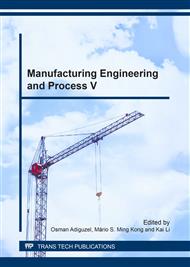[1]
P.C. Paris, M.P. Gomez and W.P. Anderson: The Trend Eng Vol. 13 (1961), p.9.
Google Scholar
[2]
R. Jones, L. Molent, S. Pitt and E. Siores: In ECF16 Proc. Edited by Gdoutos, July 3-7 (2006).
Google Scholar
[3]
R.G. Forman, V.E. Kearney and R.M. Engle, J. of Basic Engineering Vol. 89 (1967), p.459.
Google Scholar
[4]
E.K. Walker, ASTM STP 462. Philadelphia: ASTM (1970), p.1.
Google Scholar
[5]
W. Elber, Eng. Fract. Mech. Vol. 2 (1970), p.37.
Google Scholar
[6]
W. Guo, C.H. Wang, and L.R. Frose, Fat. Fract. Eng. Mat. Struct. Vol. 22 (1999), p.437.
Google Scholar
[7]
AL. TH. Kermanidis and SP. Pantelakis, Fat. Fract. Eng. Mat. Struct. Vol. 24 (2001), p.679.
Google Scholar
[8]
R. Stofanak, R. Hertzberg, G. Miller, R. Jaccard, K. Donald, Eng. Fract. Mech. Vol. 17 (1983).
Google Scholar
[9]
J. Petit: Theoretical concepts and numerical analysis of fatigue (Birmingham 1992).
Google Scholar
[10]
E.U. Lee, G. Glinka, A. Vasudevan, N. Iyyer N. Phan, Int. J. Fatigue Vol. 31(2009), p.1858.
Google Scholar
[11]
C. Laird, ASTM STP 415, Philaaelphia, 1967, p.131.
Google Scholar
[12]
H. Mughrabi, R. Prass, H.J. Christ and D. Puppel, Chemistry and Physics of Fracture, p.443.
Google Scholar
[13]
C. Masuda, A. Ohta, S. Nishijima and E. Savak: J. Mat. Science Vol. 15 (1980), p.1663.
Google Scholar
[14]
R. Sunder and P. K. Dash: Int. J. Fatigue Vol. 4(2) (1982), p.97.
Google Scholar
[15]
Y. Uchida, M. Shimojo and Y. Higo: J. Mat. Science Vol. 34 (1999), p.2411.
Google Scholar
[16]
J. Siegl, J. Schijve and U.H. Padmadinata: Int. J. Fatigue Vol. 13(2) (1991), p.139.
Google Scholar
[17]
Katsuaki Furukawa: Mat. Scie. Eng A Vol. 285(2000), p.80.
Google Scholar
[18]
A.A. Shanyavskiy, L.M. Burchenkov: Int. J. Fatigue Vol. 50 (2013), p.47.
Google Scholar
[19]
M. Benachour, A. Hadjoui, M. Benguediab, N. Benachour: Proc. Eng. Vol. 2 (2010), p.121.
Google Scholar
[20]
H. Tada, P. Paris: The stress analysis of cracks handbooks. Del Research Corporation, (1973).
Google Scholar
[21]
A.J. McEvily, H. Matsunaga: Transaction B-Mechanical Engineering Vol. 17(1) (2010), p.75.
Google Scholar


